I'm back with another fantastic recipe for you: cauliflower rice mushroom risotto. Now, this is not your traditional risotto, which is made with arborio rice. Instead, it has an AIP compliant recipe twist. A healthier mushroom risotto means that you can enjoy a delicious meal without feeling like you've done your body a disservice. You'll know you're putting good things in and getting the nutrient-dense food you need, instead of the guilt we usually feel after eating something we know isn't a great choice for us.
This cauliflower rice risotto is going to suit a lot of different eating styles: AIP, Paleo, vegetarian, vegan, and certainly anyone who is looking for a delicious meal. If you're searching for frozen cauliflower rice recipes, look no further!
Let's go through the step-by-step process of this healthy mushroom risotto.
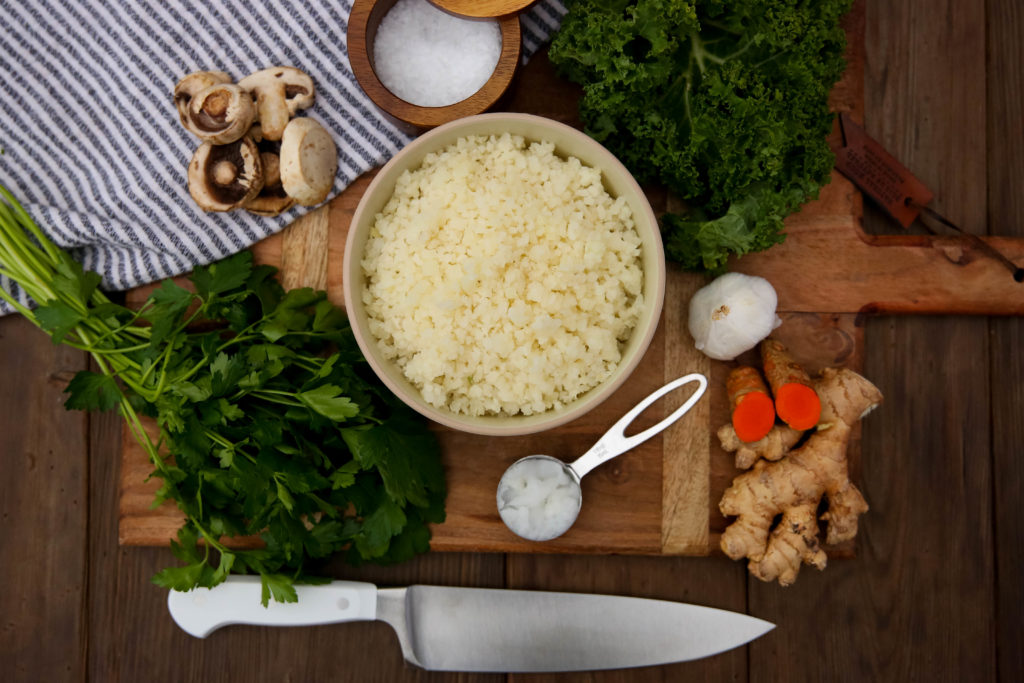
As always, you'll begin with gathering your ingredients: cauliflower rice, coconut oil, sliced mushrooms, garlic, ginger, turmeric, kale, parsley, and salt.
Add the coconut oil to your pan, then throw in the cauliflower rice, mushrooms, garlic, ginger, turmeric, and salt. You're going to saute that for about 7-10 minutes. Meanwhile, your house is going to start to smell amazing, and everyone will start asking, "What are you cooking?"
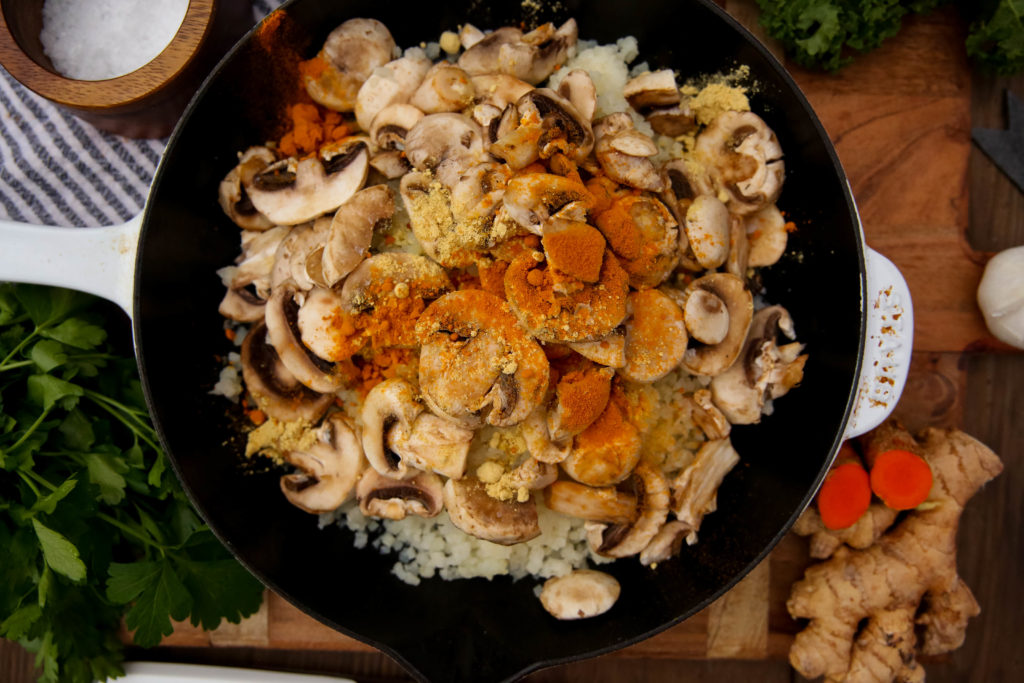
Looks pretty amazing, right? Now, you're going to want to eyeball things and maybe even give it a taste. If you think it needs more ginger, garlic, or turmeric, go ahead and add it. And salt, too, for that matter -- I am a big fan of pink Himalayan sea salt myself, and I tend to be pretty generous with that.
Next, you'll toss in your parlsey and kale.
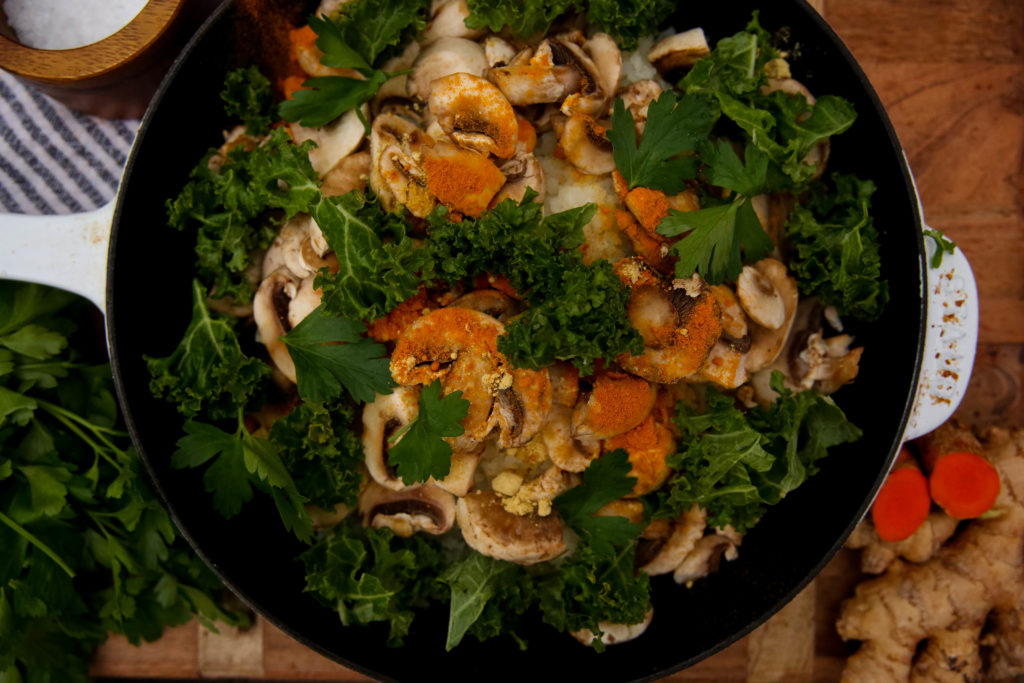
Once everything is in the pot, give it a good stir and let it all hang out together for a few minutes. The flavors will meld and everything will get combined. The kale will have a chance to wilt a bit, which makes it easier to chew and enjoy.
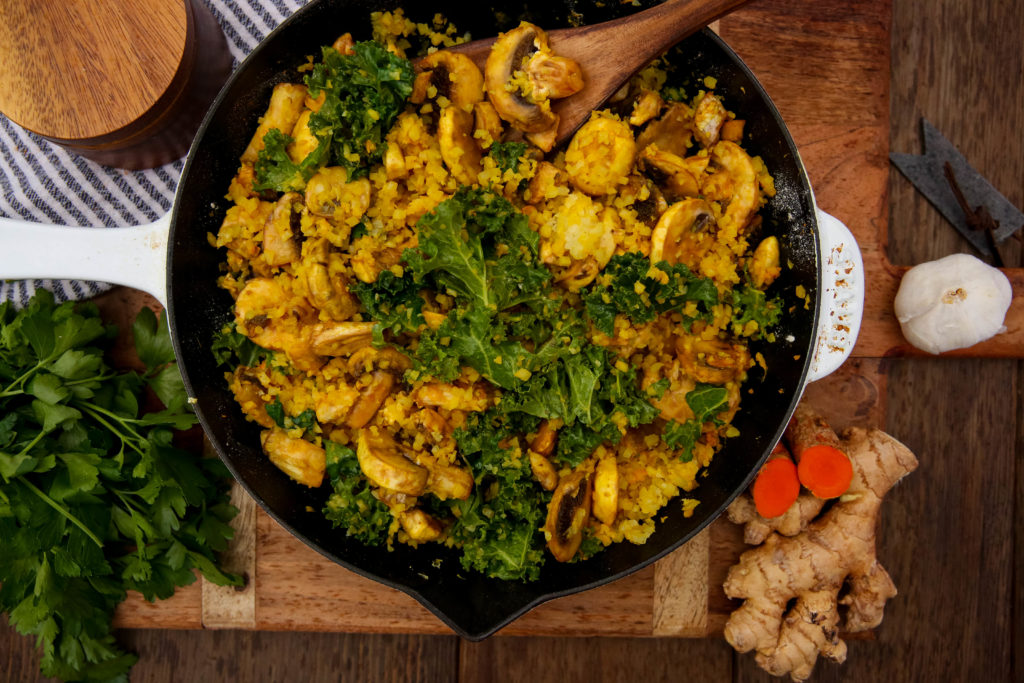
You can serve it right from the pan. This is a quick risotto, so if you're looking for fast and healthy dinner ideas that won't take long to get on the table, this is going to be perfect.
If you're looking for a wild mushroom barley risotto, you're in luck. You can absolutely switch out the cauliflower rice with a grain, if you know you tolerate it.
I'm not big on grains for a couple of different reasons. First, the pesticides used on grains are so detrimental. And grains aren't always well-tolerated in the gut, either. So that's why I chose cauliflower rice for this recipe. You could do a barley wild mushroom risotto, or even use arborio rice like would be used in a traditional risotto recipe. These grains won't have the quick cooking time as a frozen cauliflower rice, however, so just be aware of that!
Yes! Many people choose a keto style of eating, which involves having very few carbohydrates. This recipe is a keto cauliflower rice mushroom risotto. If you're eating keto, you can absolutely make and enjoy this dish without having to worry about it being full of unwanted carbohydrates. Interested in finding out more about keto eating? Check out this article.
I'd say that this healthy mushroom risotto recipe is pretty flexible. You could definitely switch it up and do a cauliflower rice risotto with asparagus and mushroom, for one. Or prepare some veggies of your choice beforehand and add them in for a roasted vegetable risotto. Consider adding a protein for a chicken vegetable risotto. The possibilities are seemingly countless, if you have a little creativity...or some extra things in the refrigerator you'd like to use up!
Yes! This recipe is appropriate for anyone who is eating autoimmune protocol paleo. It is dairy-free, gluten-free, soy-free, and doesn't involve ingredients that are typically found to be allergens. This healthy mushroom risotto can be made with any additional ingredients that are suited to your preferences, too. With cauliflower rice, mushrooms, and kale, it's truly a powerhouse of nutrient density.
Interested in the full recipe? Here it is!
That's it -- a super easy, tasty, and nutritious meal can be on the table in about 15 minutes.
Enjoy!
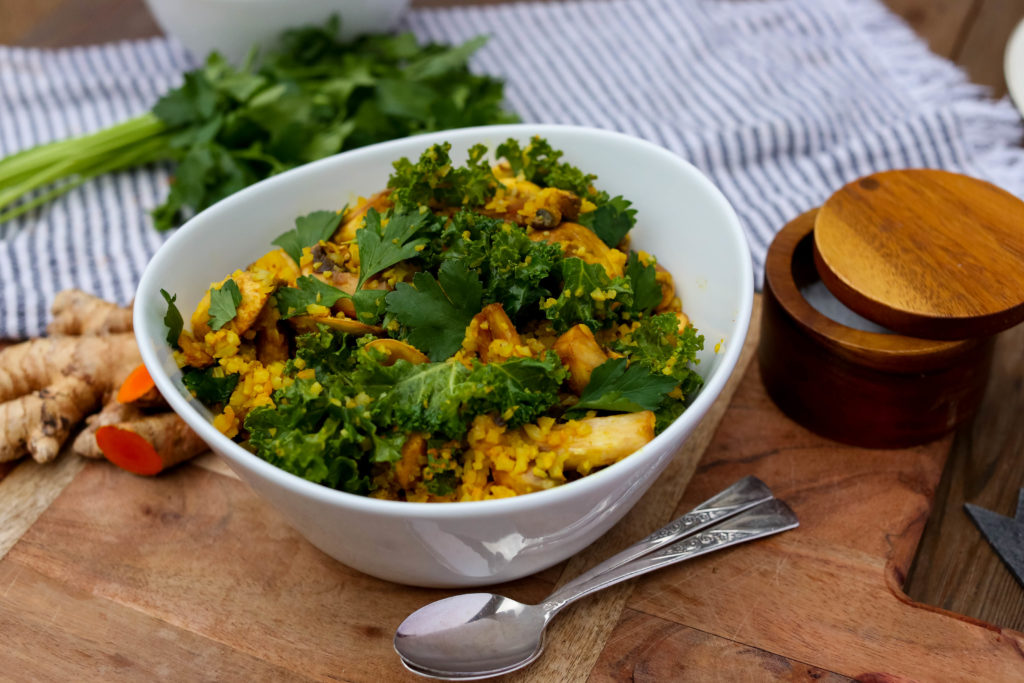
I'm excited to share another recipe with everyone: shepherd's pie with ground turkey!
It's a great choice for dinner, and pretty simple to make.
Shepherd's pie is a classic dish from England. It's also commonly referred to as cottage pie, though there are slight differences in the original recipes for each. So if you've had either before and enjoyed it, then this recipe is going to be perfect for you. If you're searching for a savory sweet potato pie-type recipe, then you're in luck. The sweet potato topping in this recipe substitutes for what is traditionally a white potato topping -- giving this healthy shepherd's pie an extra nutritional bang for your buck.
Unlike your typical shepherd's pie recipe, this is a ground turkey shepherd's pie recipe. Most shepherd's pie recipes are made with ground beef. When you want to switch it up with a different meat to get in your protein, this shepherd's pie with ground turkey will be perfect.
So, let's get into it!
Your first step in creating a healthy shepherd's pie is to gather all your ingredients. This recipe for shepherd's pie with ground turkey doesn't have a laundry list of ingredients, which is nice for those of us who don't want to spend too long in the kitchen!

Next, prep your sweet potatoes. Preheat your oven to 375° Fahrenheit, making sure it's ready for your finished product to cook at the end. Halve the sweet potatoes lengthwise, then rub with coconut oil. You don't have to skin sweet potatoes -- the skin will easily peel off after they've been roasted! Place the sweet potatoes with the flesh-side down on the cookie sheet, then place in the oven. Bake for about 30 minutes, or until you test them with a fork and find them tender.
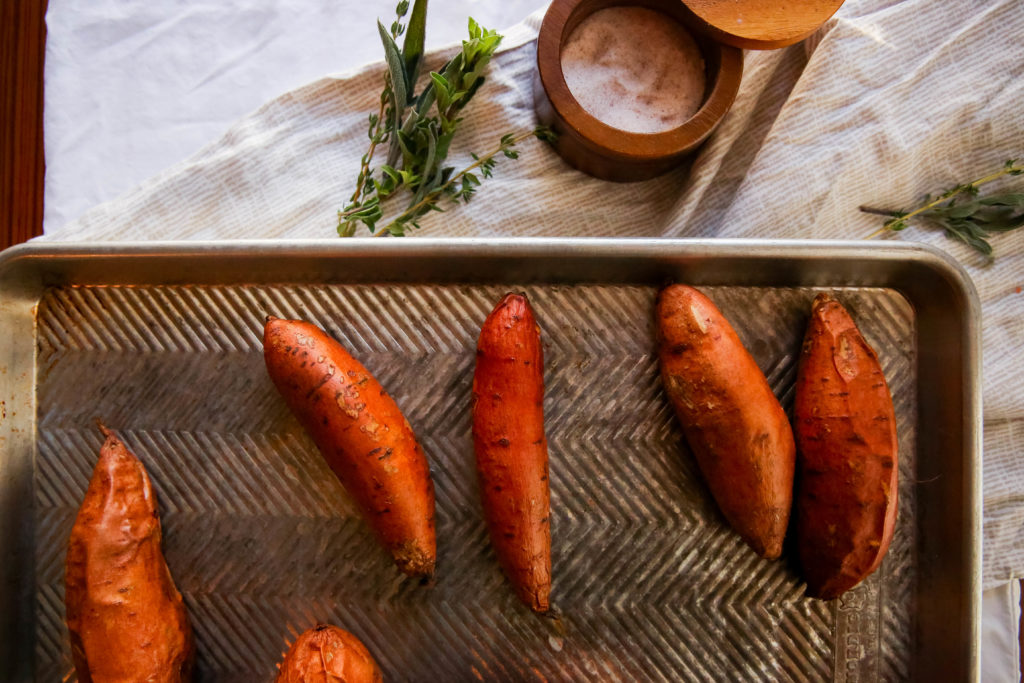
While the sweet potatoes bake, it's time to get the rest of your gluten-free and dairy-free shepherd's pie ready. For this, you're going to want an oven-safe pan, such as a cast iron. You'll cook in this and then put it right into the oven to finish, which means less dishes to wash later!
Chop carrots, onion, and mushrooms (or you can even buy sliced mushrooms, as I did for my version, which cuts down on your prep time!). Add the carrots and onion to a medium-sized pan along with the ground turkey. Turn on medium-low heat, and use a spatula to break up the ground turkey as it cooks. Toss in your salt, sage, oregano, and thyme, and let it all simmer together.
The veggies will absorb flavor from the turkey and herbs as they cook and soften.
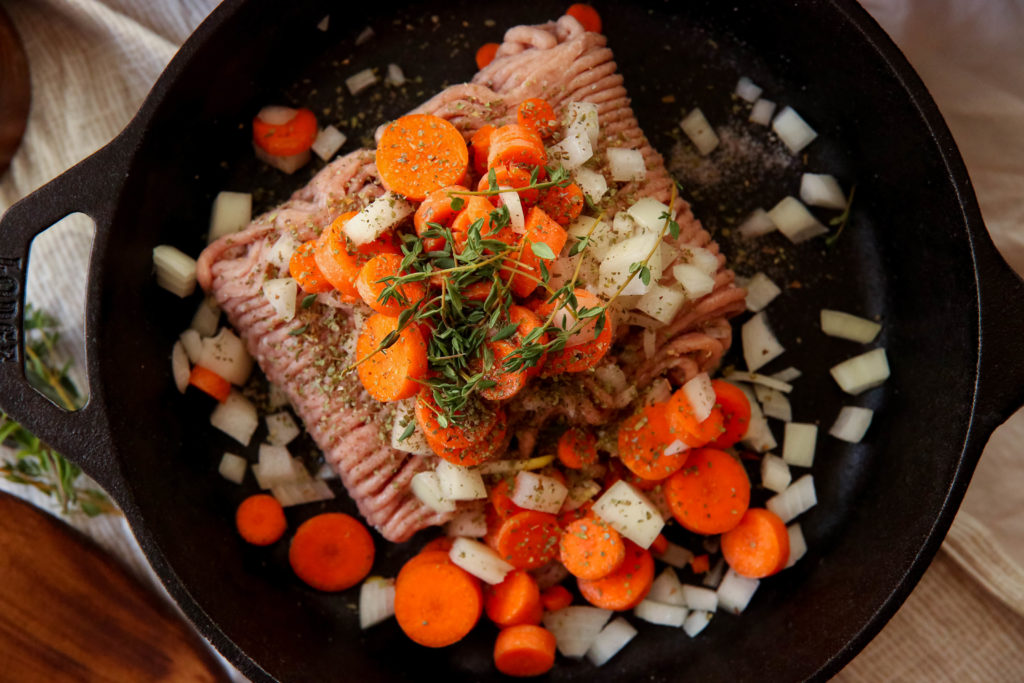
You'll cook this wonderful combination of ingredients for about 10 minutes in total. Then, throw in your sliced mushrooms, allowing them to soften up for about 5 more minutes.
At this point, it's time for a taste test. Make sure you like all the balance of flavors and seasoning in your shepherd's pie with ground turkey, adding any more as to your preferences.
Now, it's time to take your sweet potatoes out of the oven. When you do, crank the heat up to 425° Fahrenheit, because that's the heat level you'll need when it's time to bake your ground turkey shepherd's pie.
When sweet potatoes are cooked, the skin becomes pretty easy to remove. Place all the peeled sweet potatoes in a bowl. Use a fork or mixer to whip the potatoes up, adding salt to your taste.

You're in the home stretch now!
Gently spread your mashed sweet potatoes over the mixture that's in your skillet. Don't worry too much about getting it perfectly even, but spread it as well as you can. You can think of the sweet potato as a top that will keep everything under it tender and juicy as it bakes in the oven, letting all the flavors meld together.
Bake for 10 minutes at your new, higher oven temperature, then remove and serve!
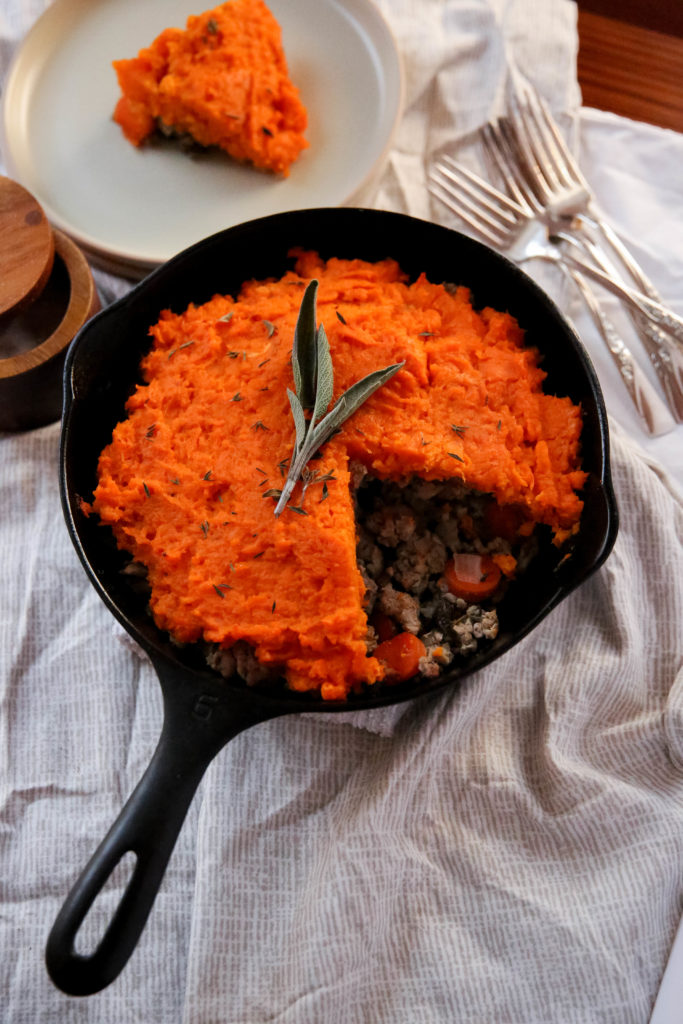
Yes! Though I can't speak to all recipes, this recipe for ground turkey shepherd's pie is gluten-free. If you find you're sensitive to gluten (and far too many people are these days, trust me) then this is a safe recipe to follow.
Yes! This recipe for shepherd's pie with ground turkey is dairy-free. It's also a paleo shepherd's pie, so it's a great choice for those of you who follow the paleo style of eating.
Leftover turkey sweet potato shepherd's pie sounds tasty, doesn't it? And I get it -- when you make a turkey, you've got tons of leftovers you need to use. You can definitely switch out the ground turkey for some turkey leftovers in this recipe. You'll want to change things up slightly, however: don't add the turkey to the skillet of vegetables until the very end, because you wouldn't want your turkey to dry out. Be sure you add some coconut or avocado oil to the pan before you put the vegetables in, so they have something to soften in while you cook them.
In my recipe for shepherd's pie using ground turkey, we're making some pretty healthy switches to a traditional recipe. Turkey is a nutritious form of protein that is heart-friendly. This shepherd's pie is gluten-free and dairy-free, removing two big allergens that people have problems with nowadays. And rather than traditional white potatoes making up the mashed topping, I've switched them out for sweet potatoes.
Sweet potatoes are a fantastic starch choice, full of
A lot of people wonder, what's the difference between cottage pie and shepherd's pie? With shepherd's pie, the meat involved in the recipe is typically made with ground lamb or mutton. Cottage pie, however, uses ground beef. So, this recipe could be considered a version of either of these -- but with a healthier, more nutrient-dense twist!
See below for the full details!
Happy eating!
When it gets cold outside, soup is what you want to have on your dinner menu! Or lunch...or maybe even breakfast...
...and who wouldn't enjoy a quick, simple, hearty butternut squash soup?
Most of us are pretty pressed for time in this busy, chaotic, and stressful modern world we live in.
So, I thought it would be the perfect time to share my paleo & AIP butternut squash soup. I want the recipes I share to tend toward AIP, or autoimmune protocol. Why? Because that's what I've seen so many of my students benefit from eating. If there is an ingredient that isn't AIP-compliant, it can be easily left out in most recipes. I've noted that in the recipe ingredient list for this particular recipe, so you can change it up to suit the way you want to eat.
A hearty butternut squash soup is something that can appeal to nearly anyone. This particular butternut squash soup with coconut cream is warming, healthy, and filling -- without compromising on the flavor.
The fresh herbs give the taste a real pop, though you could substitute a smaller amount of dried herbs if you don't have fresh on hand. This recipe is pretty forgiving, so if you find that you're out of ginger, don't worry -- proceed with the remaining ingredients and see how it turns out. You may even find that you like it better that way!
None of us want to spend hours in the kitchen. I wanted my hearty butternut squash soup to be fairly simple. Here's your ingredient list:

This AIP butternut squash soup is pretty simple to get cooking.
Here is each step:


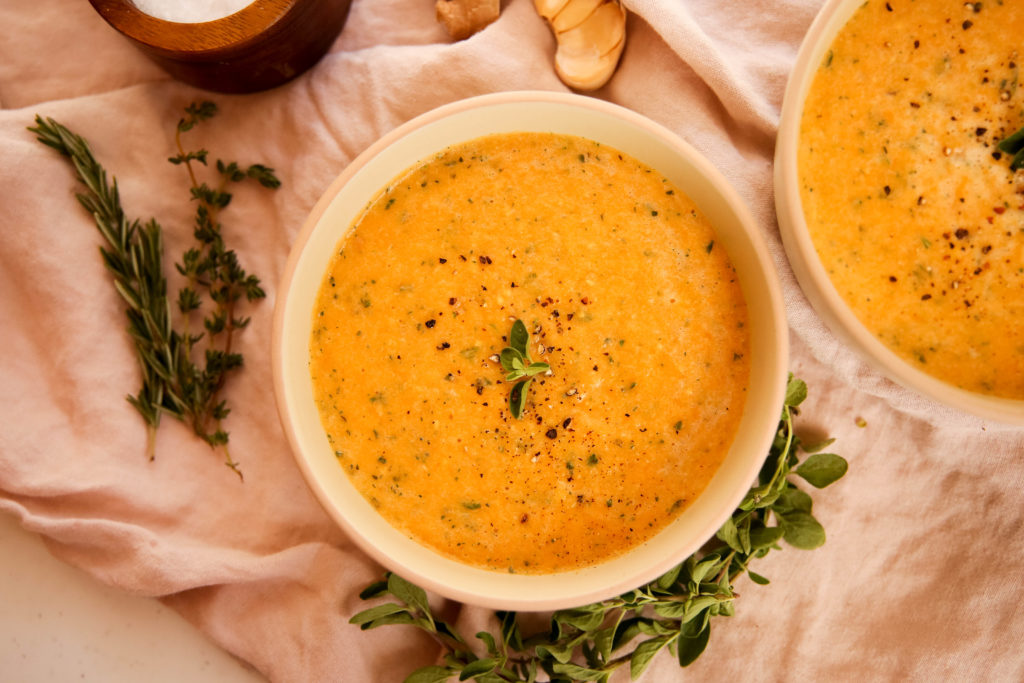
As you can tell from the directions, it really doesn't take long to prepare this meal. You'll have it on the dinner table in no time!
Wondering if you can use coconut milk in butternut squash soup? Coconut milk is far more common in kitchens and pantries than coconut cream is. You can absolutely switch out coconut cream for coconut milk if that's what you have on hand. Or if that's all you can find at your local grocery store. Please note, however, that the soup will be less thick if you use coconut milk. It will still have a great flavor, though!
Many people wonder what to eat with butternut squash soup. The search is over! Serve this over cauliflower rice. It's warming, delicious, herby, and filling, too! If you'd like something else served alongside this AIP butternut squash soup, I highly recommend a salad. Some mixed greens, cucumbers, and olives is pretty simple, but so good, and a fresh complement to the warming, filling soup. Top your salad with extra-virgin olive oil and some balsamic vinegar for a zing.
Bread with hearty butternut squash soup is a no-brainer, but if you're eating AIP, conventional breads aren't going to be what you'll eat. Instead, give this recipe a try from Cook 2 Nourish for AIP sweet potato dinner rolls. You'll love dipping them in your soup!
Nobody likes wasting food, right? It's like watching money go right down the drain. So if you're wondering how to handle leftover butternut squash soup, here's what I would recommend: freeze it! Yep, that's right. Just as you'd freeze a fresh batch of bone broth (which, by the way, you could absolutely add to this recipe), you can freeze butternut squash soup. I recommend doing so in jars, or in another glass container, rather than using plastic. Whenever you know you need something easy for dinner, pull out a jar and let it thaw during the day or in the fridge. When you get home at night, all you have to do is heat and serve!
Get the full recipe below!
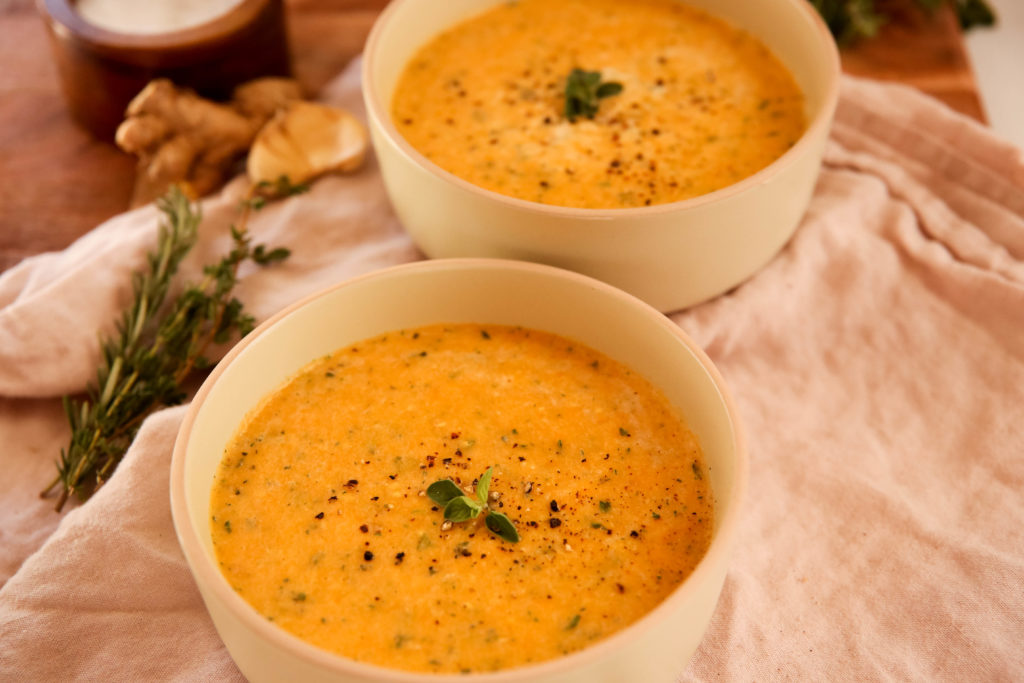
I hope you enjoy this one, because I plan on sharing more recipes in the near future. Meanwhile, check out the rest of my blog posts to find some good reading material!
The state of health in the Western world isn't looking too good right now. In more than 35 years in practice, I've seen that our health is sliding consistently downhill. The average person is really suffering -- and unnecessarily so.
In America, we are arguably the sickest nation there is. We spend more on health care than the next 10 countries combined.
Yet we have more disease than any other nation.
And some of these diseases were not even in existence until more recently. Things are getting worse, not better.
America makes up about 5% of the world's population, but we consume 50-60% of the world's pharmaceuticals.
Clearly, this is not a recipe for good health.
I recently read the other day that the current generation being born in the U.S. is expected to be the first generation that will not outlive their parents.
It's because of the choices we're making and what we're being exposed to.
The amount of health issues we have is daunting. And I think it's just the tip of the iceberg. If we don't start to address the root cause of WHY we are sick, we are in for a tsunami of health crises.

 You've heard me mention it before: the cells of the body. They're our foundation. Everything that happens in the body, has to occur at the cell level. That means when something is wrong, it's because the cells aren't working as they should.
You've heard me mention it before: the cells of the body. They're our foundation. Everything that happens in the body, has to occur at the cell level. That means when something is wrong, it's because the cells aren't working as they should.
No disease or symptom occurs independent of the cells. None!
The membrane is like the brain of the cell. It lets in good stuff like nutrients, hormones, and oxygen. And it also lets the bad stuff, like waste and toxins, get out. The dynamic of "good stuff in, bad stuff out" is what keeps you health.
The reason that so many people are unhealthy is because the cells are damaged, and aren't working like they should.
People come to me all the time and says, "What are some simple switches I can make?"
I have four principles that I inform these people about.
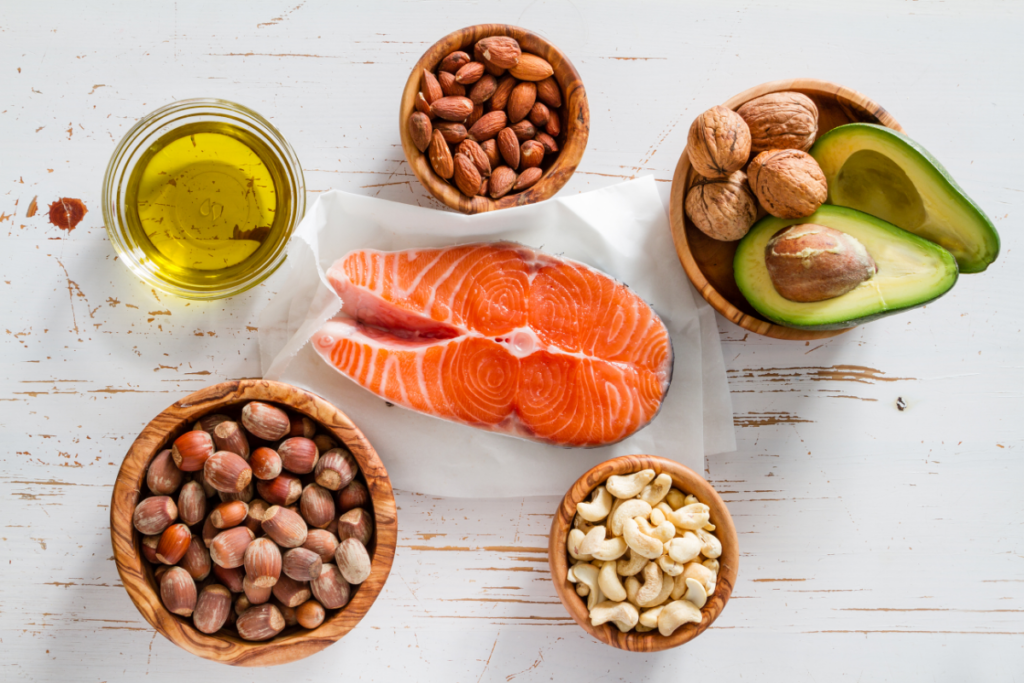
Get rid of the bad, inflammatory fats like vegetable oil, corn oil, canola oil, trans fats, and margarines. They are rancid and cause dysfunction and disease. But then at the same time, you need to add in good fats. Why? The cell membrane is made of two layers of fat. it should be semi-permeable, but it loses permeability from being chronically inflamed. But you can heal the membrane! Consume good, healthy fats like
You can also switch out unhealthy proteins for better choices. The beef or chicken we eat shouldn't be what's kept in a cage where the animal develops disease because of the unsanitary conditions they live in. Or when farmed fish are raised in a pen and fed an unnatural diet, turning their meat gray and then being dyed orange to make it look more appealing. The way these animals are being raised actually changes the makeup of the meat, and it becomes an inflammatory food.
Look for grass-fed beef. Free-range chicken and eggs. Wild-caught fish. Avoid farmed fish and conventionally farmed animals.


This is a big one. Today, we consume far too many carbohydrates. It's not just sugar, either. Foods that turn into sugar include rice, pasta, breads, biscuits, cereal -- all the things I was raised on! I came from the time of the food pyramid, where we were told to have 6-11 servings of those foods each day. It's no wonder we're sick and overweight.
We've got to cut out the foods that contain sugar, or readily turn to sugar. It's what is driving so much inflammation at the cell level.
Sugar damages the gut as well as drives inflammation in the body. It really upsets the gut ecology. Have you heard of the gut-brain connection? If you have a damaged gut, you will wind up with brain-related symptoms, too. A damaged gut disturbs your digestion, so you won't digest and assimilate your food like you should. Your gut is likely chronically inflamed, and you may even have a "leaky gut," which feeds more inflammation throughout the body.
If you're going to have sugar, you need to have the natural versions. Honey, in moderate amounts. Fruit like berries and apples (buy organic whenever possible!).
Most people don't drink enough water. And then, the water they DO drink is chlorinated and fluoridated. Chemicals like chlorine are designed to kill things. So what effect do you think that has on the body?
The natural microbiome the body has plays a huge role in the gut-brain connection and on our brain function. When we disturb the balance of bacteria in the body, the bad bacteria begins to proliferate.
You have to make sure the water you're drinking is clean.
I have a well at my house, and I've had it tested to make sure the water quality is good. But I still bought a Berkey countertop filter. You pour a gallon in, and then you know that's about what you'll drink in a day. We have one in the office, too, and it does a great job of purifying water.
If you are willing to make these four switches, I promise you: it will make a difference. You need to be diligent and stay strict about it.  Most people try to justify eating bad goods because they also ate a good one that day. But that's throwing gasoline on the fire. You have to put out that fire if you're truly going to improve your health.
Most people try to justify eating bad goods because they also ate a good one that day. But that's throwing gasoline on the fire. You have to put out that fire if you're truly going to improve your health.
Try these changes for 90 days. Set your mind to it. Clean up what you're putting in the body. Get rid of the bad stuff and only take in the good stuff. Start healing your gut and brain, and you're going to see a tremendous transformation in your health, like I do with nearly all of my clients.
Today, I want to discuss one of my all-time favorite subjects. It probably affects you, or someone you love.
It's low energy.
So many of my clients want to know, "Why am I suffering from low energy?" "Is there a way to get my energy back?" "Why don't I have any energy?"
It's rare that I have a client who DOESN'T complain of low energy. When we ask, "Where is your energy, on a scale of 1-10?" The answer is usually somewhere between two and five.
People are feeling just...diminished. Their quality of life takes a hit from that lack of energy.
So what I want to do is make you understand what low energy really is. In doing so, you know how you can help yourself start to get out of that rut. 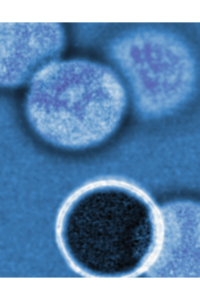
The cells of our body allow good things (like nutrients) to get in, and the bad stuff (like waste products) to get out. But when we we get...
...then we end up damaging the membrane of the cells of the body. this membrane is supposed to be permeable, allowing the good things to get in and the bad things to get out. But chronic inflammation causes the cell membrane to become impermeable.
So now, let's turn to how energy is made.
The way energy is made in our body is through mitochondria. They're our little energy factories. The mitochondria produce something we call ATP, which acts as gasoline for our cells.
If you aren't producing enough ATP, you're running low on gasoline.
People with chronic inflammation, even if they currently eat a good diet, the nutrients they take in can't get into the cell. Then, they don't have the raw materials to make the energy they need.
The result is a deficiency of ATP. You're low in energy thanks to cells that are chronically inflamed.
And at that point, you'll start to crave carbs and sugar.
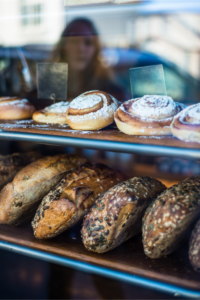
Why?
Because it's the fastest form of energy! If you don't have enough energy, you'll start to crave that fast energy.
But here's the beautiful thing: when you start dealing with this energy problem and fix the cell membrane, you can actually address the root cause of low energy.
When you fix the cell, you can start making more ATP. Your energy level will shoot up, and bonus: you won't crave sugar anymore!
You CAN break the habit. You CAN set yourself free. A constant craving for sugar is not natural. But when the cells start receiving the good stuff, those cravings will decrease, and you'll be free. With this freedom, you can take your health to wherever you'd like it to be.
If you want more details, please visit ColeClass.com to learn about my root cause perspective that has helped thousands of clients.
There is a big problem in our society today that I want to talk about: weight loss resistance.
In today's society, it is an epidemic problem. Mostly, weight loss resistance affects women. But more and more men that I'm seeing, no matter how little calories they consume, no matter how much they exercise, they simply have lost the ability to burn fat.
Just like everything, I have to ask, "What's the cause?"
It's all due to an underlying hormone problem, but it's different than what you might initially think. If you went to the average person and asked them about hormone problems, they'd probably say that it's due to "not having enough hormones." They'd assume a man has low testosterone, or a woman is deficient in estrogen.
I'm not saying that doesn't exist, but it typically is not what the root issue is. Most people are actually dealing with the inability of those hormones to get into the cells of the body and do their job!
It all goes down to the cell level, which is exactly what we do in my practice. Our cells are our foundation. Everything happens at the cell level -- including any dysfunction you have. Whether it's feeling tired all the time or the inability to lose weight, you can trace it back to the cells. 
So let's talk a little bit about that. The typical person that we see is a female who is experiencing health problems, most often tied to thyroid health. They have become hormone resistant.
The hormones in the body that help burn fat, such as T3, the active thyroid hormone, and leptin, which is the master control hormone, can't get into the cell. The membrane of the cell has been damaged by factors such as
Because of these factors, the hormones can't get into the cell. You've created a barrier. There are only two ways you get energy: from carbohydrates, or from fat.
Most of the people that we see are stuck in sugar-burning mode/carb-burning mode, and that's why they crave carbs. They're going from meal to meal to meal, utilizing carbohydrates as their fuel source, and as a result, their bodies have become pretty bad at tapping into their fat reserves.
So, you have to change this dynamic. You've got to fix the cell. You've got to eliminate toxins. You've got to start eliminating bad fats. Eliminate the sugars. You need to replace the bad fats with good fats because the cell membrane is made of fat, so you want plenty of good fats in the body.
I know: you've been told time and time again that fat makes you fat. It causes heart disease and other health problems. But I'm telling you, nothing could be further from the truth!
You have to make a distinction between good and bad fats. 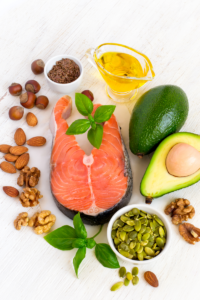
When you put all these factors into play, you can fix your cells and become less hormone resistant.
There are other benefits, too. For example, if you skip a meal, would you normally get shaky or weak? That's a typical symptom of a sugar-burner. But when you're a fat burner, your body will naturally turn to using your fat stores for energy.
Each day, I get to hear about success stories from my practice of people who get incredible results from fixing the cell. They might have had hormone issues for decades. But when they address their health on a cellular level, these people can reclaim the normal physiology of the body. It's an exciting thing!
Here's the bottom line: to beat weight loss resistance, you've got to turn yourself over into a fat burner instead of a sugar burner. You do that by getting rid of sugar, by getting rid of bad fats, by eliminating or finding out where these toxins are in your life, and in reducing them as much as possible. And then you add good fat into a nice, clean diet, and you're going to start to see changes like everybody that we see in our practice.
If you want to hear more about cellular health, please consider watching my FREE Masterclass!
Let's start by defining a few things. In our gut, we have this internal environment that is made up of what we would call "good bacteria," and "bad bacteria." A balance between the two is integral to our health. 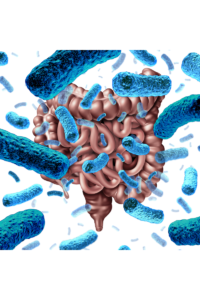
We're finding out so much more about how the health of our gut is related to everything in our body, from brain function to energy levels, to the ability to lose weight and digest your food. The list is just endless because it has to do with all parts of us.
These are things we didn't know that long ago, but we're finding out more and more that the balance in this internal environment is playing such a role in our health.
 The father of modern medicine, Hippocrates said over 2,000 years ago that he believed all disease begins in the gut. I don't know if that's entirely true, but I know so much of what we see disease-wise today has some relationship to a bad gut. So, we want to make sure our gut is healthy.
The father of modern medicine, Hippocrates said over 2,000 years ago that he believed all disease begins in the gut. I don't know if that's entirely true, but I know so much of what we see disease-wise today has some relationship to a bad gut. So, we want to make sure our gut is healthy.
So, let's talk about these microorganisms that so many of the patients that I see are deficient in. They're deficient in these things because of the foods that we're eating in large part, antibiotics we've been taking, antibacterial soaps, the chlorine we drink in our water, and the pesticides that we may have in our foods. These things that are designed to kill living things or wiping out our internal environment, really decimating our good bacteria, and they're allowing the bad bacteria to take over.
We need to change that dynamic. If you're having anxiety, if you're having brain fog, energy issues, you have to understand that any solution starts with a healthy gut. You need the ability to digest your food. Even if you're eating a good diet, but you're not able to take advantage of that because your gut is so bad that you're not able to digest and assimilate the good food you're eating, you're not going to get that benefit from those foods.
We want to talk about a couple of things here. But there's two things I want you to understand: prebiotic and probiotic. Most of us have heard about probiotics. These are the actual microorganisms. The good stuff that's in our gut and helps us do all of these good things. A lot of people today are taking probiotics, but I want you to understand something. Man is never going to put into a pill what God provided for us in our food.
The best probiotics might already been in your kitchen. My four favorite probiotics are raw sauerkraut, kimchi, kefir, and kombucha.
When you eat sauerkraut, you have to make sure that it's raw sauerkraut. If it's been cooked, the probiotics, the good bacteria have been destroyed.
Kimchi is a Korean dish. It's kind of similar to sauerkraut in the sense that its base is cabbage, but it tastes different. They have spicy versions of it, but you usually will find this in a health food store. 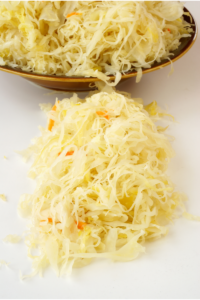
Kefir is something I absolutely love. If you're not sensitive to dairy, making your own kefir is what I really recommend for people who have this abnormal relationship between good and bad bacteria. It's loaded with the good probiotics. I like to start with raw goat's milk. There are all kinds of recipes online. It's so much better than anything you're going to buy in the store if its source is that raw milk to begin with. Organic, grass-fed milk is going to be your absolute best choice. Kefir is super easy to make, and it's super loaded with probiotics.
Kombucha is something a lot of people don't know about. It's a fermented tea. A lot of stores are carrying it now. It comes in different flavors.
Working these four things into your diet are going to provide you with the probiotics that you need to repair a gut when it's been damaged after a lifetime of abuse.
Prebiotics are not that well understood. We hear so much about probiotics, but we don't hear all that much about prebiotics. That doesn't mean you should underestimate the importance of prebiotic foods, however! Let me give you an analogy. 
You remember the Pac-Man game back in the day where the yellow Pac-Man was eating the dots? Imagine that the Pac-Man is the probiotics, a living organism. The prebiotics would be the dots that the yellow Pac-Man eats. It's the food for the probiotics. 
These are the foods here that are most readily-accessible for most people, but just understand that concept that the probiotics eat the prebiotics. So, it's nourishing the probiotics and supporting this healthy environment in our gut.
Some of the prebiotics you can enjoy include raw garlic, raw leeks, asparagus, and onions. You can cook the onions or have them raw.
In essence, what you really need to understand is that high-fiber foods are going to be good for you from a prebiotic perspective. I hope that helps you guys understand that if you want to fix your gut, you've got to make sure you got the healthy bacteria. But you have to make sure that you have the food that allow the healthy bacteria to thrive.
Interested in supportive products for your gut? We have a whole store you can browse through. Head to https://keycellularnutrition.com/shop/ and take a look around!
I've always done case histories with my patients when they first come to the office. Back in the day, we would ask them about their anxiety. Do they have any anxiety symptoms? It was really a lot rarer back then. Today, it's pretty common, to the point that a full 40 million Americans have been diagnosed with an anxiety disorder. That's 20% of our adult population, and it's getting worse. That's scary!
When we're talking about anxiety, it can be anything from generalized anxiety disorder to full blown PTSD and everything in between. Ultimately, it’s even affecting us physically. We can wind up with chronic fatigue-type syndromes, constant muscle tension, and pain in our body. Even insomnia may occur, where people can't fall asleep, or if they do fall asleep they have trouble getting back to sleep upon waking in the middle of the night. That's something I see all the time.

The real issue is what we're doing for it treatment-wise. The pharmaceuticals that are being used today are really hit and miss, at best. But the problem is that they all have side effects! You see, there's no such thing as a drug without side effects. Every drug is a toxin. I'm not saying there's not a time and a place to take these pharmaceuticals. I'm just telling you that every drug is a toxin. Nobody would argue that. That's why they have side effects, and unfortunately these side effects with these types of medications for anxiety and depression can be onerous.
And now, we know they increase the likelihood of developing Alzheimer's disease. Can you imagine that? Here, we have a medication that you're taking for your brain that increases your likelihood of developing Alzheimer's, the fastest-growing disease in our society today.
Well, here’s the good news. In my years of experience, I've seen natural things that not only work just as well, but don't have any side effects. The good thing is they often times will get to the root cause of why the person has anxiety to begin with. There's never been a medication that's going to address the root cause of your problem because you don't lack medications. That's not why we develop anxiety or things like depression.

But, when you do these two things that I'm going to tell you right now, and incorporate them into your life, if you're like most of our patients, you're going to see some really positive results.
#1. Exercise
This first one is probably something you've already heard about. We are a nation of couch potatoes, right? Whether it's the jobs we have, whether they're sedentary or whether it's being on a computer all day long or our smartphones, or we're watching television. A lot of us are just not getting the exercise or activity or movement in our lives that we need, that our body needs to be healthy.
The great thing about exercise is that there's so many different kinds. What I've found to be the most effective for the brain and for the hormones is something called high-intensity interval training (HIIT). There are all kinds of ways to do it. 
If you're on a treadmill, instead of being like a gerbil on a treadmill where you're going for 60 minutes at the same pace, you're going to alter the pace of your workout, and it might only be 10 or 12 minutes long in total. Maybe even less in the beginning! How nice is that? You have an extra 50 minutes in your day to do other things that are going to be productive for you.
So here's how it works if you're on a treadmill: you warm up, get yourself loose, and then you increase the speed. You could increase the incline instead, or do a combination of both. You want to get to the point for 30 to 60 seconds that the exercise makes you breathless. Makes it difficult to talk. Your heart is beating rapidly, right? That type of intensity is going to do wonderful things for blood flow, for your hormones, and for your mind and body in general.

After that 30 to 60 seconds, you back it down again. Go back to that walking speed, and then you catch your breath. That will take about two minutes, and then you do it again. Another 30 to 60 second burst at higher speed or incline, then another rest.
To start with, you might only repeat this cycle 2-3 times. Over time, as you become more conditioned, you want to build that up to where you're doing six of these bursts each session. What's great is that you don't need to do this type of exercise every day. The hormone benefits that come from this will last for a good 36 hours after you're done. So, just do this type of exercise every other day!
#2. Diet
Besides the exercise, you want to change what you're doing diet-wise. If we're going to talk about root cause, you can't get away from what I teach my clients all the time, which is that every symptom and every disease can be traced back to the cell level of our body. You see, our cells are our foundation. They're the building blocks. They're the smallest living unit of all of us. This is where all function takes place, and if you're suffering from dysfunction, it is a guarantee that your cells have been impacted negatively. They're damaged and inflamed, which is when you'll start to notice symptoms occurring.
So let's take it down to that cell level. The membrane of each cell is composed of two layers of fat. It's called a bilipid layer. That bilipid layer is where the good stuff gets in and the bad stuff gets out. It allows that cell to stay healthy.
Unfortunately, things like too much sugar, too many bad fats, and too many toxins in our life will damage this membrane. And if this is your brain cells, and your brain cells are inflamed, that is potentially going to cause things like brain fog, anxiety, and depression.
So, if we want to get down to that root cause level, we've got to affect the function of our cells, the health of our cells, and you're going to do that by stopping this consumption of too many bad fats and too much sugar, and we want to try and eliminate toxins as much as we can, too. There are definitely better choices you can make when it comes to your diet and anxiety.

Speaking of diet, you should know that the average American consumes 120 to 150 pounds of sugar per person, per year. Do you know there was a time when it was 5-10 pounds per family per year? You can see just how off the charts that we are, and that doesn't include the artificial sugar! A lot of these artificial sugars are neurotoxins, meaning they damage our brain whenever these brain cells come in contact with these neuro-type of toxins.
So, we want to get rid of the bad fats. We want to get rid of the sugar. The bad fats are going to be corn oil, vegetable oil, canola oil, margarine, and things like trans fats. We need to switch to the good oils. The healthy oils are needed because the cell membrane is made of two layers of fat. Your brain is made of 60% fat. Just from that, you can understand how essential fat is for the function in our body.
We just have to start make a distinction between bad fats and good fats.
Good fats would be extra virgin olive oil, virgin coconut oil, avocados, grass-fed beef, wild-caught fish, free range eggs, right? These are going to be the healthy fats. And grass-fed butter! Don't forget that. Our ancestors ate a lot of butter. This will help to heal that fatty membrane and your brain, which again, is 60% fat.
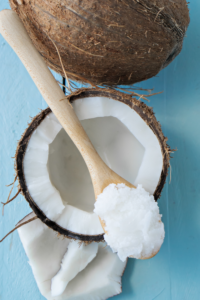
When it comes to sugar, it's not just about cutting out candy. Think of foods that readily turn to sugar. For those of you that are already inflamed and have symptoms, even some relatively healthy foods like whole grains can be bad. This is because four seconds after they touch your lips, these grains begin breaking down into sugar in your body, and your body is too sensitive to sugar right now because we've over-consumed sugar. We're carb-a-holics in this country, and even in western society in general.
So, we want to cut back on the breads, the biscuits, the bagels, the rice, the pastas, and the cereals. All the things that we have way over-consumed for way too long.
When you do these two things, exercise the way I described, and get rid of the sugar and bad fats, then start working on healing yourself by adding in the good, healthy fats to your diet, you're going to start to see changes, just like my clients do.
For those of you who prefer a more visual learning experience, I have a great YouTube video on this subject that I really encourage you to check out. There are even more on my YouTube channel for you to check out if you would like to learn more. I hope this helps!
The other while I was working out at my gym, something struck me. There might have been about 15 people there; it wasn't very crowded. What struck me was that about 2/3 of the people there were women. Back in my day, my brother I owned a Gold's Gym in our hometown for 10 years. Maybe about 10% of our members were women. Probably not even that. Things have changed, and you'll find more and more women understanding the benefits of exercise, weight training in particular.

As a natural health practitioner, I've not only seen in my own life in how training helped me reverse some developing health problems that I had at one time, but it's also something that I've seen play a really valuable role in allowing my clients to accomplish their health goals.
A lot of times, we think of weight training like something that will bulk you up. Today, you would think that those myths would be dispelled. But there's still a lot of women that believe that lifting weights makes them bulky. Nothing could be further from the truth, and you have to start reapting the benefits of weight training if you're not already!

Years ago, I wanted to raise my life insurance, and the life insurance company sent a doctor to my office. They drew blood and came back a week later. I had failed the examination. Here I am, a guy preaching health, and I failed the life insurance exam. I let myself go, and was doing things opposite of what I was telling my patients to do. I was just letting life get in the way. A lot of us are guilty of that, right? Living a life of convenience often means letting our health slide.
I was busy. I had multiple practices. We had the gym business. Plus, I had four young kids. I just let things get in the way. I was shocked that I could fail that exam. 
The insurance company came back and told me that I had high blood pressure, high cholesterol, high triglycerides, that I had a fatty liver, my liver enzymes were elevated, and I was pre-diabetic. That's just what the blood test showed!

What I didn't explain to them was that I was dog-tired, I had brain fog, I had sleep issues, skin issues, and a lot of other symptoms that pointed to deteriorating health at a pretty young age. I was only in my 40s at the time. The thing that was really a punch to the solar plexus was failing that exam. It made me realize that I've got to go back and do the things that I was preaching to my patients.
So, I did it. I began doing everything that I'd always told my patients to do if they wanted to be healthy. A little bit over six months later, I had really changed physique-wise. More importantly, I had changed health-wise. All of my issues went away. My high cholesterol, triglycerides, blood pressure, and all. I was no longer pre-diabetic. All those symptoms disappeared. 
I felt like I took 20 years off the clock. I was reinvigorated!
It just made such a difference not only in how I looked, but how I felt. I became so much more productive. My mind became clearer. Exercise played a role in that, too. Yes, you have to change your diet! You have to quit throwing gasoline on a fire, or that fire, like we always preach, is the cells of our body that are inflamed and damaged. That's where sickness and disease begins.
And here's the proof:
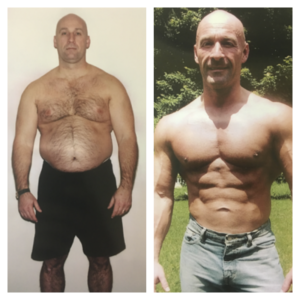
But besides diet, exercise plays a big role. Yes, it can change the way that you look, but that's more cosmetic. If you're interested in that, if you want to lose weight, if you want to tone up, there's absolutely nothing in my experience that's more productive than a combination of weight training and what I would call burst training, or high intensity interval training.
It doesn't take a lot of time to train like this. I spend no more than 30 minutes in the gym each time I'm there. Sometimes, if I'm only there doing burst training, I might only be there for 10 or 12 minutes! Then I'm back to my regular day. A lot of times, I do a workout at home. I have an elliptical trainer at my house, and I'll use it to do my burst training.

My point to you is that what it did for me, besides change how I looked, is that it was useful in helping me get my health back! Exercise helped me with regaining lost strength, increasing blood flow, improving my brain, and relieving my joints of the soreness that I felt all of the time. It made a tremendous difference in my quality of life.
So, here is a rundown of what this type of exercise can do for you:
✅ It reduces inflammation in your body
✅ It resensitizes hormones in your body
✅ It makes your cells more receptive to hormones
That's how I was able to help get rid of my pre-diabetes. I was insulin resistant, but by resensitizing those cells, I was able to completely get rid of that.
Today in my practice, we have Type II diabetics regularly who come to us, who have been told by their medical doctor "There's nothing you can do, you are destined for a lifetime of taking this medication." We say, “Baloney!” There are things you can do! The evidence is out there, but the medical doctors are not reading their own research!
About 90-95% of Type II diabetes is completely reversible if you catch it early enough for sure, and if you address the root cause behind your diagnosis (you can learn more about this concept in my FREE Masterclass, which you can find at ColeClass.com, if you're interested). 
Nobody is diabetic because they lack Metformin. The MDs wanted to put me on cholesterol medication and blood pressure medication, and I said, "No way; that's not what's going to fix my problem. I've got to address the reason why my cholesterol and my blood pressure and my triglycerides were elevated."
Changing my diet, getting an exercise program, weight lifting with high-intensity training or burst training -- that's what turned it around for me.
Know, though, that if you lift weights, you can just walk in the gym, grab a weight, do some repetitions, and stop.
What I see too often, especially with older folks like me, not really lifting in a beneficial way. What I noticed when I was at the gym the other day is that the females really knew what they were doing. 
They were pressing it, and their last repetition was to near failure for some of these women.
One was doing overhead presses, and another was doing seated rows. They understand this concept that whenever you do resistance training, you want to take that to the point of near failure. You want to keep good form the whole time; you don't want to overdo the weight to the point that you end up hurting yourself, but in that 8, 12, even 15 repetition range, that last repetition should be tiring. You should barely be able to make it, and then when you're done (especially with bigger muscles like legs, back, shoulders, and chest), you should feel a little bit winded because anaerobically, you're working hard.
Lifting weights like that is going to be tiring, and that's exactly what you want.

That's my advice today -- look into doing a resistance training program in addition to changing your diet.
You don't have to spend a ton of time exercising. It can be 20 to 30 minutes, 3-5 days a week depending on the energy that you're going to exert each time. You can see pretty dramatic change with just a minimal amount of time spent in the gym. Don't let time be your excuse.
Make the time for it, and you will see the benefits, just like I did. It'll not only change how you look, but it'll change how you feel, and it'll do things on the inside that a lot of people have never been made aware of. That's where true health comes from.
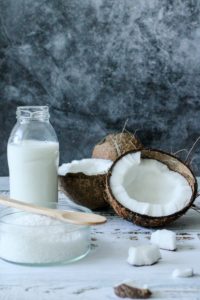
You might wonder why I use coconut milk over traditional cow's milk, or even choices like almond milk. Coconut milk is really, really rich in healthy fat. That's what is a big missing ingredient in the typical American diet, especially sick people. We've been told that we shouldn't have fat. That it makes us fat. That it gives us heart disease, especially saturated fat. Well, nothing could be further from the truth. It's something that we need to help heal ourselves, help burn fat, make hormones, and just regulate brain functions. There's so much about healthy fat that we need. That it does what we need in our body.
I wanted to make mention of something else that people tend to have misconceptions about. This smoothie adds up to about 500 calories, which isn't too bad. A lot of people have been on calorie-deprivation diets for too long.
But there is still something to the idea that consuming too many calories when your body's not effectively able to burn those calories, especially the fat calories. That's something you need to work yourself into.
In the beginning, you might want to use a quarter or a third of the can of coconut milk. Over time, you'll notice your body becomes better at burning calories, and then you can start to use more and more of the coconut milk. But subtracting some of the coconut milk or fruit will keep your carbs down if you want to do that, and you don't need to add in any honey to sweeten if carbs are your concern.
 Don't be afraid to experiment with this breakfast recipe -- add in some spinach or anything else that will give it a nutritional boost! Healthy breakfast ideas don't have to involve complex recipes or costly ingredients.
Don't be afraid to experiment with this breakfast recipe -- add in some spinach or anything else that will give it a nutritional boost! Healthy breakfast ideas don't have to involve complex recipes or costly ingredients.
If you like getting information on nutrition, I highly recommend that you head over to my YouTube channel. I've got quite a few videos on there that will be of interest to you!
